3.1 Introduction to Device Fabrication
半导体公司可以分成三类:
- integrated semiconductor companies: both design and fabricate ICs
- fabless: only design the circuits
- foundries: specialize in manufacturing
根据 IC 的规模,可以分成:
- LSI (large-scale integration, 104 transistors on a chip)
- VLSI (very large-scale integration, 106 transistors on a chip)
- ULSI (ultra-large-scale integration)
- GSI (giga-scale integration).
一个简单的制造过程如下:整个过程是在一片 wafer (晶圆)上制造的,先构造 ${\rm SiO_2}$ 层,然后选择性的去除某些部分,然后在这部分的表面引入杂质离子,最后使杂质离子扩散进硅。

这种一层一层将电路做在 wafer 上的技术叫 planar technology
3.2 Oxidation of silicon
silicon dioxide 有两种用途:
- serving as a mask against dopant introduction into silicon
- serving as the most critical component in the metal-oxide-semiconductor transistor
有两种方式制造 ${\rm SiO_2}$ layer,对应两种化学反应:
- dry oxidation:${\rm Si+O_2 \rightarrow SiO_2}$,slow and thin
- wet oxidation:${\rm Si+2H_2O \rightarrow SiO_2+2H_2}$,fast and thick
步骤如下:
- wafer loading:Si wafer 先放在 quartz boat 上
- insertion into the furnace:推到 furnace 中进行反应
- ramping of the furnace temperature:furnace 的反应区一般是用 clear fused quartz 或 SiC 或 polycrystalline Si 制造的,通过 electrical resistance heating coils 加热到 700–1,200 °C
- gas control:通入氧气或用carrier gas带出水汽来进行反应,
- 整个过程是自动化控制的。
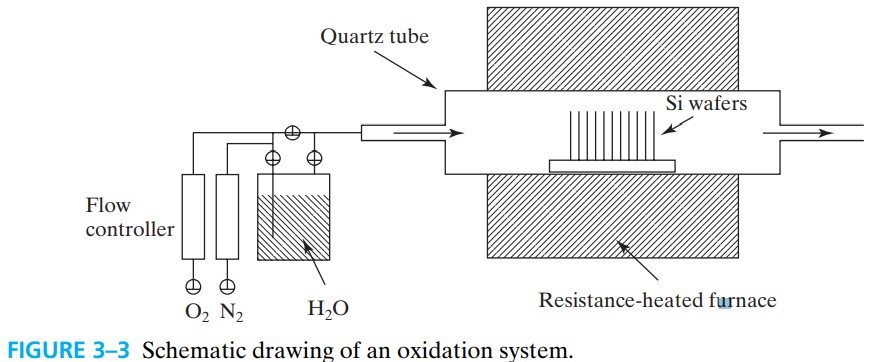
可以通过控制氧化温度和时间来控制厚度。另外, the ambient gas 和 the Si surface orientation 也会影响厚度(这也是为什么要沿 (100) plane 切)。
3.3 Lithography
要选择性去除氧化层,要通过光刻,光刻分为两步:图形曝光(photolithography or optical lithography 以及刻蚀(etching. 步骤如下(1~4为图形曝光,5~6为刻蚀):
- 覆盖光刻胶(也叫抗蚀剂 photoresist,an ultraviolet (UV) light sensitive material):Liquid photoresist is placed on the wafer, and the wafer is spun at high speed to produce a thin, uniform coating.
- 前烘: a short bake at about 90 °C is performed to drive solvent out of the resist.
- 曝光:expose the resist through a photomask and a high-precision reduction lens system using UV ligh
- The photomask (掩模版) is a quartz photoplate containing the patterns to be produced
- negative resists (负胶,曝光不溶):the areas where the light strikes become polymerized and more difficult to dissolve in solvents
- Positive resists (正胶,曝光溶):contain a stabilizer that slows down the dissolution rate of the resist in a developer. This stabilizer breaks down when exposed to light, leading to the preferential removal of the exposed regions.
- 显影:用显影剂溶解未固化的光刻胶,然后将硅片冲洗和甩干
- 去除氧化层:Buffered hydrofluoric acid (HF) may be used to dissolve unprotected regions of the oxide film
- 去除光刻胶 (resist strip):This is accomplished by using a chemical solution or by oxidizing or “burning” the resist in an oxygen plasma or a UV ozone system called an asher.
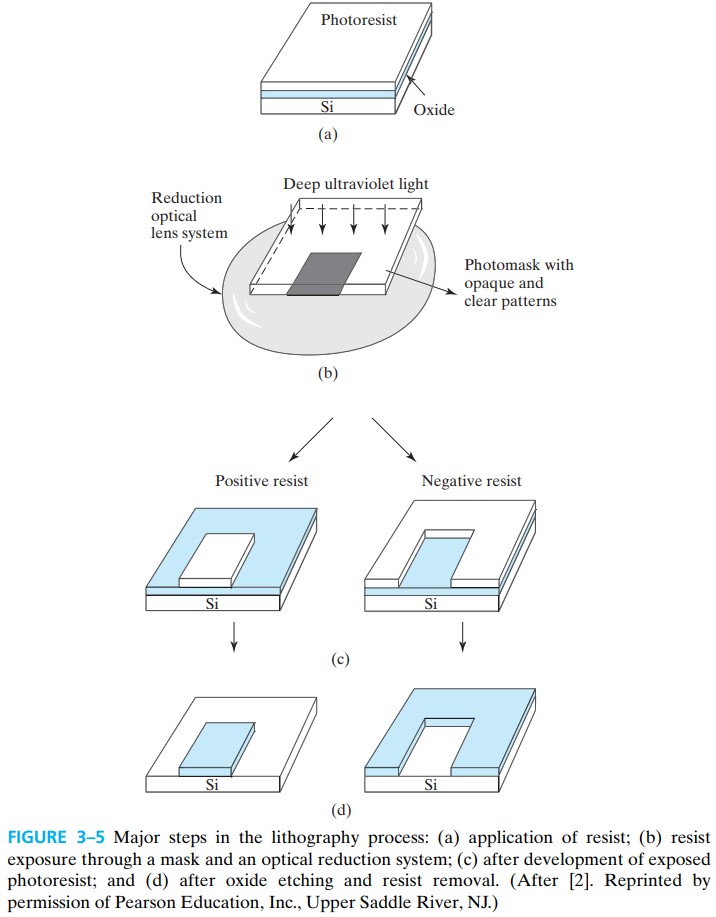
曝光的分辨率受光波长和光学衍射限制,可以用下面公式表示:
\[\text{Lithography Resolution}=k\lambda\]- 减小光波长:难, lack of suitable transparent materials for lenses and mask plates
- 减小 k 值:
- 减小曝光范围(lithography field ),用 stepper 移动 wafer 直到全部曝光
- 优化 photomask,用 optical proximity correction (OPC) 修正,避免相邻线之间相互影响
- 使用 phase-shift photomask:产生两束靠得很近的光,两光相位相反,在中间产生的衍射恰好相互抵消
下面介绍多种曝光方法。
3.3.1 Wet Lithography
wet lithography or immersion lithography 简单来说就是在 lens 和 photoresist 中间放水,因为有折射,所以波长会减小:
\[\frac{n_1}{n_2}=\frac{\lambda_2}{\lambda_1}\]
3.3.2 Electron Lithography
electron-beam lithography 就是直接用电子束将光刻胶去除,因为电子束的波长远小于光,所以分辨率更高。不过由于电子束需要逐点扫描(不用掩模版),效率很低,一般用来验证设计。
3.3.3 Nanoimprint
Nanoimprint 不需要曝光,直接像盖章一样将 patterns 压在一层 soft coating 上,然后经过 coating hardens 得到图形。
3.4 Etching
刻蚀就是将曝光得到的 photoresist 上的pattern 转移到下一层(${\rm SiO_2}$)。有两种刻蚀方法:
- wet etching:${\rm SiO_2}$ is removed with ${\rm HF}$
- 特点:isotropic(各向同性)material selectivity好
- dry etching:also known as plasma etching or reactive-ion etching or RIE,用等离子去轰击
- 特点: anisotropic(各向异性的)material selectivity差,有可能造成某些破坏(antenna effect)
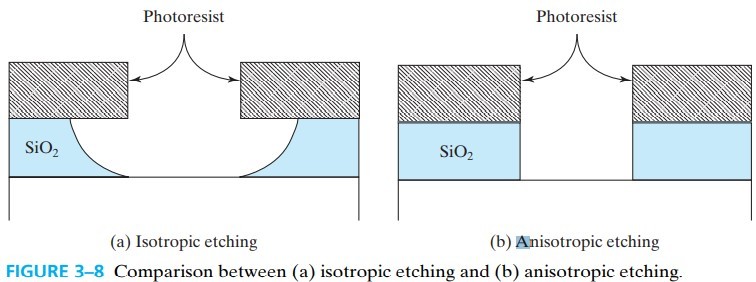
3.5 Doping
掺杂分成两步:
- 在表面放上杂质原子
- ion implantation
- gas-source doping
- solid-source diffusion
- 扩散进内部 drive-in diffusion
3.5.1 Ion Implantation
就是将 ions 加速到很高能量,然后射到表面。会对晶体造成破坏,所以需要通过 anneal for damage removal and for dopant activation
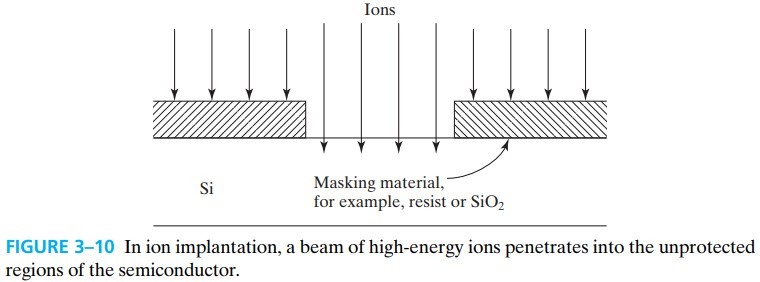
3.5.2 Gas-Source Doping
只适用于掺 phosphorus(磷),因为只有磷有合适的气体。这个过程类似于 3.2 的wet oxidation,只不过将水换成了 ${\rm POCl_3}$,发生的反应如下:
\[{\rm 5 POCl_3 \xrightarrow{>600 ℃} 3PCl_5+P_2O_5}\\ {\rm 2P_2O_5 + 5Si \rightarrow 5 SiO_2 + 4P\downarrow}\]3.5.3 Solid-Source Diffusion
先在硅表面弄一层包含 dopant 的薄层,然后等到 dopants 扩散进去后移除薄层
3.6 Dopant Diffusion
The dopant impurity diffuses with time at high temperature. 将相反的杂质掺进去可以得到 PN junctino,它的 junction depth 指的是从表面到 $N_a=N_d$ 的厚度。杂质原子的浓度与深度的关系满足高斯分布:
\[N(x,t)=\frac{N_0}{\sqrt{\pi D t}} e^{-x^2/4Dt}\]- $N_0$ is the number of dopants per square centimeter and is determined by the dopant addition step
- $x$ is the distance into the semiconductor
- $D$ is the diffusivity for the given impurity and furnace temperature
- $t$ is the time for the diffusion step
3.7 Thin-Film Deposition
除了掺杂外,我们还需要再硅表面做各种膜(氮化硅、二氧化硅、各种金属),有下面几种方法
3.7.1 Sputtering
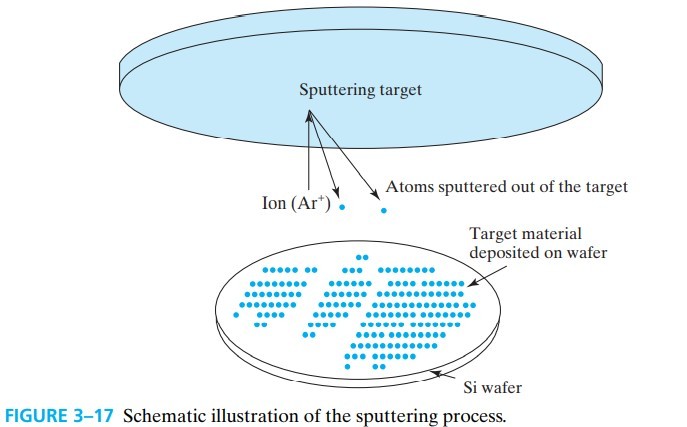
- Sputtering is performed in a vacuum chamber
- sputtering target(提供原子源的材料)和 wafer 形成一对平行面板
- 抽真空后,充入 sputtering gas (typically Ar)
- 先让 Ar 电离,形成等离子体,然后加交变电场,让 Ar 轰击 sputtering target
- 轰击下来的 target atoms 沉积在 wafer 上
整个过程主要是用物理方法,所以也叫 physical vapor deposition (PVD)
3.7.2 Chemical Vapor Deposition (CVD)
PVD 不能覆盖垂直的地方,所以需要 CVD to deposits a much more conformal film. 大概过程就是两种气体反应形成固体,然后沉积在 wafer 上
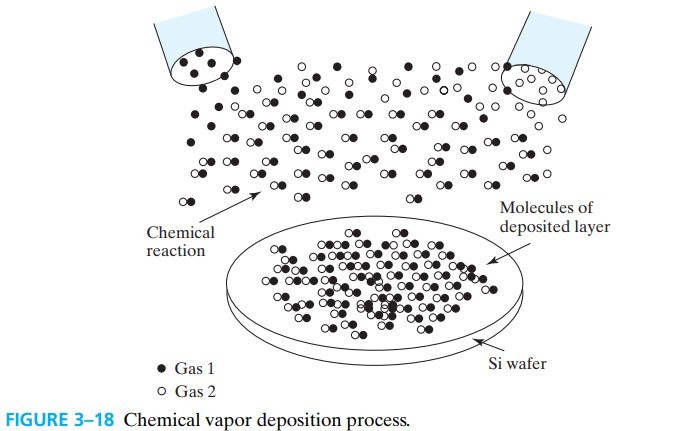
常用的 CVD 包括:
- high-temperature oxide (HTO)
- lowpressure chemical vapor deposition (LPCVD)
- plasma-enhanced chemical vapor deposition (PECVD)
3.7.3 Epitaxy
Epitaxy(磊晶;外延)用于在晶体上长晶体。方法于 CVD 类似, at sufficiently high temperature, an arriving atom can move over the surface till it stops at a correct location to perfectly extend the lattice pattern of the substrate crystal.
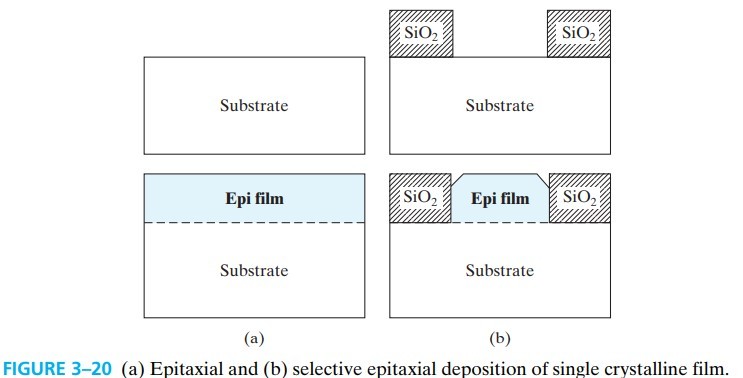
3.8 Interconnect - The Back-End Process
将器件用金属线连接的过程称为 metallization,过程如下:
- 移除二氧化硅
- PVD 形成金属膜
- 通过刻蚀移除多余的金属
一开始用的是 Aluminum,但 Al 存在 electromigration(原子随电流迁移),所以现在都是用 Cupper。